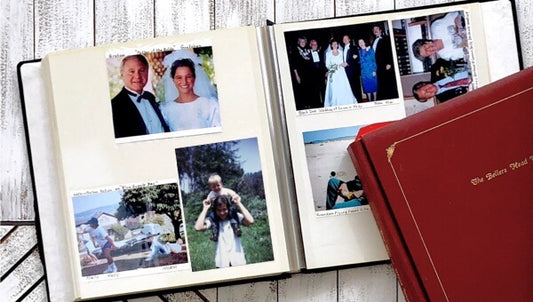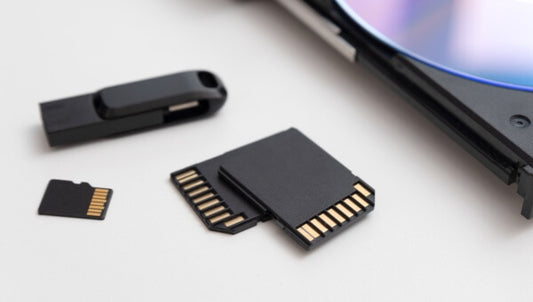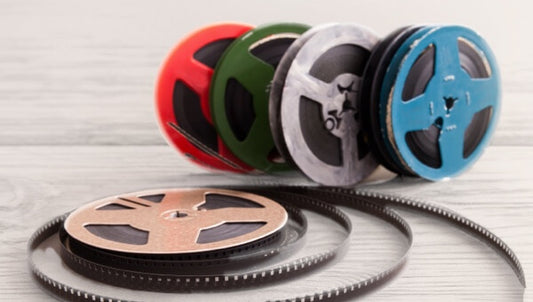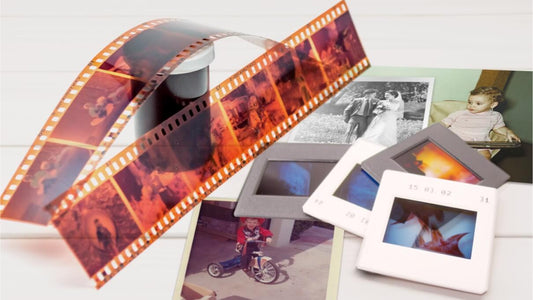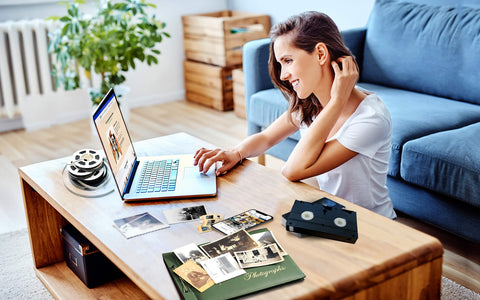Disposable cameras are simple film cameras designed for one-time use. They capture photos on preloaded 35mm film and are developed through chemical processing instead of digital files. Whether it’s a Fujifilm disposable camera or a Kodak single-use camera, the basic mechanism is the same. When you press the shutter button, light enters through the lens and exposes the film, creating a permanent image.
Today, these nostalgic cameras are making a comeback. Once popular in the 80s, 90s, and early 2000s, disposable film cameras are again used at weddings, vacations, and events. The global market for disposable cameras is even projected to grow significantly by 2028.
Keep reading to learn how disposable cameras work, their main parts, film development process, history, and what makes them different from other camera types.
Table of Contents
- What Does a Disposable Camera Do
- Components of a Disposable Camera
- How Does a Disposable Camera Work
- Exposure, Aperture, and Shutter Speed in Disposable Cameras
- Flash and Low-Light Performance in Disposable Cameras
- How to Get Disposable Cameras Developed
- Advantages of Disposable Cameras
- History of Disposable Cameras
- Differences Between Disposable and Digital Cameras
- Preserving the Magic of Disposable Cameras
What Does a Disposable Camera Do
A disposable camera is a compact, single-use film camera designed to make photography simple. It captures images on preloaded 35mm film, which must be developed through chemical processing. When you press the shutter, light passes through the lens and exposes the film, creating a permanent image.
They’re called “disposable” because both the film roll and camera body are intended for one-time use, once the film is developed, the casing is typically recycled or discarded.
Components of a Disposable Camera
To understand how disposable cameras work, it helps to know what’s inside. The main parts of a disposable camera include the casing, shutter, lens, film, viewfinder, and flash circuit.
Disposable cameras have a durable plastic or cardboard casing that protects all internal components, including the preloaded roll of 35mm film. They usually come with color film, although black and white disposable cameras are also available. Many feature an exposure counter that shows how many photos remain on the film roll.
The optical viewfinder is the small window you look through when taking a picture. While similar to the viewfinder on analog cameras, a disposable camera viewfinder is made from simple convex plastic designed for one-time use, giving you a basic but clear framing of your shot.
Most models use a fixed-focus lens with a focal length between 30mm and 32mm. The disposable camera lens focuses light onto the film when the shutter opens. The shutter speed is typically around 1/100s, making it easy to capture quick, well-lit images. For example, a Kodak FunSaver includes a plastic lens, manual film advance, and 27 exposures, while a Fujifilm QuickSnap Flash 400 uses Fujifilm 400-speed ISO film and a plastic 32mm lens.
Not all disposable cameras include a built-in flash, but those that do use an AA battery and a flash charge button. The flash circuit enhances brightness in darker environments, helping users get clearer photos in any lighting condition.

A disposable camera captures moments on preloaded film and is meant for single use.
How Does a Disposable Camera Work
Now that we’ve covered the components, let’s look at how a disposable camera works step by step. Inside a disposable camera, every part has one goal - capturing light and turning it into an image on film.
When you press the shutter button, the plastic lens focuses light onto the roll of light-sensitive film hidden inside the casing. The shutter briefly opens, allowing just enough light to reach the film before closing again. This process exposes the film to light, creating a latent image that will later be revealed during film development.
The film itself contains several layers, including a base layer, emulsion layer, and protective coating. When light hits the emulsion, it triggers a chemical reaction that records the scene as a pattern of bright and dark areas. That’s the foundation of how disposable camera film works.
Using the camera is simple: wind the film to the next frame, look through the viewfinder, press the shutter, and, if needed, activate the flash. This disposable camera mechanism is consistent across brands, from a Kodak disposable camera to a Fujifilm QuickSnap, so anyone can take photos without adjusting aperture or shutter settings.
Because everything is fixed, these cameras are ideal for quick snapshots, vacations, and events. The straightforward disposable camera design makes them reliable, portable, and easy to use, even for beginners. The easy, point-and-shoot design also makes them thoughtful presents for dad, perfect for capturing family memories in a nostalgic and personal way.

Every part, from the lens to the flash, works together to create lasting film images.
Exposure, Aperture, and Shutter Speed in Disposable Cameras
On a disposable camera, exposure, aperture, and shutter speed work together to control how much light reaches the film. Because these settings are fixed, users don’t need to adjust them manually - one reason disposable cameras are so easy to use.
Most cameras have an aperture between f/10 and f/11, which determines how wide the lens opens when taking a photo. A smaller aperture like this means a deeper depth of field, keeping more of the scene in focus. The disposable camera aperture cannot be changed, which helps ensure sharp photos in most lighting conditions.
The shutter speed is typically around 1/100 of a second. This fixed disposable camera shutter speed allows just enough light to hit the film for a well-balanced image. However, it also means there’s less flexibility in motion or low-light photography compared to digital or manual film cameras.
Together, the aperture and shutter speed determine the exposure - the overall brightness or darkness of your image. The disposable camera exposure remains consistent in daylight, but in darker environments, the built-in flash helps balance the light.
Some cameras, like the Kodak FunSaver or Fujifilm QuickSnap Flash 400, handle exposure using ISO 400 film, which is versatile enough for both indoor and outdoor use. Even though you can’t change the settings, you can still influence results with good lighting, flash use, and proper framing.
If you digitize old photos from your disposable camera, you can fine-tune exposure, brightness, and contrast using editing software to bring out more detail without losing that classic film look.
Flash and Low-Light Performance in Disposable Cameras
The built-in flash on many disposable cameras will help you get the right amount of light even in dim rooms. You will need to make sure that the flash is fully charged, but then it will automatically synchronize with your shutter, which means you simply point and shoot.
So, do disposable cameras work without flash? Yes - if you’re shooting outdoors in bright sunlight, you don’t need it. However, in low-light environments, using the flash ensures better disposable camera lighting and prevents underexposed images.
To use the flash, simply press and hold the flash button until the indicator light turns on. Then frame your shot, look through the viewfinder, and press the shutter. The flash fires instantly when the picture is taken.
The built-in flash has a limited range of about 1 to 3 meters, which means it works best for close subjects. Many photographers also use it creatively in daylight to fill shadows and give photos a nostalgic glow that enhances the film’s texture.
Because the disposable camera flash is fixed, it can’t be adjusted for intensity, but that simplicity is part of the charm. It guarantees consistent lighting results, especially when combined with ISO 400 film, which balances brightness across different shooting conditions.

Once used, the film is developed in a lab or at home to reveal your photos.
How to Get Disposable Cameras Developed
After you finish the entire roll of film on your single-use film camera, you need to figure out how to get disposable cameras developed.
When you take a photo, the film reacts to light exposure and records a hidden, or “latent,” image. During development, chemical solutions transform that invisible image into visible negatives.
You can either develop disposable cameras at home or send them to a professional lab. If you develop them yourself, you’ll need to carefully remove the film in a dark environment and use specific chemicals such as a developer, fixer, and wetting agent. This process requires precision and experience to prevent damage or overexposure.
For most people, the easiest option is professional disposable camera film processing. Most places where you can develop 35mm film will also develop disposable cameras. Labs like Walmart, CVS, The Darkroom, and Ilford Photo offer mail-in or in-store services that return developed disposable camera negatives and prints.
Many labs also provide digital scans so you can store and share your photos online. Once you have the digital copies, it’s easy to organize photos by event, year, or theme, keeping your memories accessible and well preserved.
The turnaround time depends on the lab, but most processing takes one to two weeks. Once the film is developed, you can print, scan, or even digitize the images to preserve them for the future.
Advantages of Disposable Cameras
Disposable cameras combine simplicity, affordability, and nostalgia in one small package. They’re portable, durable, and easy to use, which makes them ideal for vacations, weddings, or casual photography. You don’t need to adjust settings or charge batteries — just wind the film, frame your shot, and press the shutter.
Here are some of the main advantages of single-use cameras:
- Affordable photography – a budget-friendly way to enjoy film without expensive gear.
- Instant readiness – no charging or setup required, perfect for travel or events.
- Durable design – lightweight yet sturdy enough for outdoor use.
- Authentic film look – soft tones and natural grain that evoke vintage charm.
- Beginner-friendly – ideal for learning how light, focus, and composition work.
Many people love the way film photos feel more personal and imperfect, capturing memories in a raw, timeless way. It’s no wonder these cameras have made a comeback — offering a refreshing contrast to today’s digital convenience and showing exactly why disposable cameras are worth it.
History of Disposable Cameras
The invention of the modern disposable camera occurs relatively late in the evolution of the camera. Disposable cameras were invented in 1949 by Photo-Pac, which produced a cardboard camera with eight exposures. Then, in 1966 FEX, a French company, produced a 12-photo option.
It wasn’t until Fujifilm developed QuickSnap in 1986 that the disposable camera became extremely recognizable. In fact, it became one of the most iconic cameras of the 1980s. Soon, most major companies were making single-use cameras and they became popular wedding favors, vacation essentials, and mobile photography necessities.
This led to the Lomography photographic style that involved spontaneous images without worrying too much about technical implications. Additionally, more types of single-use cameras were developed like waterproof disposable cameras for underwater photography and even digital disposable cameras that were introduced in 2004 (but never caught on very much).
Since the early 2000s, disposable camera sales have been on a gradual decline. That is, until recently when the industry has been growing. The reason for this is likely nostalgia and the fun that you can have taking photos with a film camera as opposed to a smartphone or digital camera. This coincides with the rejuvenation of audio cassette players as well. There’s something special about physical analog media that people love.

Disposable cameras use film and chemistry; digital ones rely on sensors and memory.
Differences between Disposable and Digital Cameras
How does a disposable camera work versus a digital camera? Whereas a film disposable camera captures photos on film rolls, digital cameras create a digital image file that’s saved to a hard drive or memory card.
Disposable vs digital camera at a glance
Capture medium
- Disposable camera uses 35mm film that must be chemically developed.
- Digital camera records image files to a memory card.
Controls
- Disposable has fixed lens, aperture, and shutter speed. Point and shoot.
- Digital offers adjustable settings, live preview, and instant review.
Image look
- Film delivers organic grain, smooth highlights, and nostalgic color.
- Digital is crisp, clean, and easy to edit immediately.
Cost and convenience
- Disposable is low upfront cost but adds processing fees and wait time.
- Digital costs more upfront but has near-zero per-shot cost.
Output and storage
- Disposable produces negatives and prints; scans are needed for sharing.
- Digital produces share-ready files with easy backup and cloud storage.
Which is better
It depends on your goal. Choose a disposable camera for a simple, distraction-free experience and the classic film vs digital aesthetic. Choose a digital camera for control, speed, and repeatable results in varied lighting. Film can capture very fine detail, and when 35mm negatives are scanned at high DPI, you get high-resolution files; digital offers instant, consistent quality with no lab steps.
Practical tip: If you shoot film, scan or digitize your disposable camera photos so they’re safe, easy to organize, and simple to share — while keeping the original film look intact.
Preserving the Magic of Disposable Cameras
Now that you know how disposable cameras work, you can appreciate how these simple devices still hold timeless appeal. With a fixed-focus lens, preloaded film, and built-in flash, they make it easy to capture spontaneous moments without worrying about settings or batteries.
While the charm of film is undeniable, it’s smart to convert disposable camera photos to digital to keep them safe. Digitizing your negatives or prints helps preserve them from fading, damage, or loss, and makes it easy to share those moments online.
At Capture, we specialize in transforming old film, negatives, and disposable camera pictures into lasting digital keepsakes. Whether your photos come from a Kodak FunSaver, Fujifilm QuickSnap, or another single-use camera, we’ll help you safeguard every moment for generations to come.






